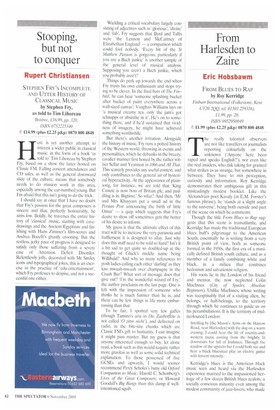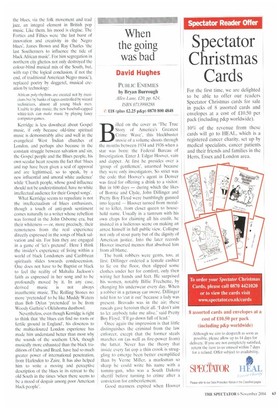From Harlesden to Zaire
Eric Hobsbawm
FROM BLUES TO RAP by Roy Kerridge FinbanInternational (Folkestone, Kent CT20 2QQ, tel: 01303 259316), £1.99, pp. 20, ISBN 0952950049 cti £1.99 (plus £2.25 p&p) 0870 800 4848 The really talented observers are not like travellers or journalists reporting colourfully on the unknown ('Anyone here been raped and speaks English?'), nor even like the real insiders, who risk taking for granted what strikes us as strange, but somewhere in between. They have to mix perception, curiosity and information. Roy Kerridge demonstrates their ambiguous gift in this misleadingly modest booklet. Like the Alexandrian poet Kavafy (in E.M. Forster's famous phrase), he 'stands at a slight angle to the universe', being both outside and part of the scene on which he comments.
Though the title From Blues to Rap suggests that this scene is transatlantic, and Kerridgc has made the traditional European blues buffs pilgrimage to the American South, essentially he is writing from a very British point of view, both as someone formed in the 1950s. the first era of a musically defined British youth culture, and as a member of a family combining white and black, in a milieu that combines hedonism and salvationist religion.
His roots lie in the London of his friend and mentor, the now neglected Cohn Maclnnes (City of Spades, Absolute Beginners). Unlike MacInnes, whose writing was recognisably that of a visiting alien, he belongs, or half-belongs, to the territory through which he continues to guide us on his perambulations. It is the territory of multicoloured London:
Strolling by [the Mason's Arms on the Harrow Road, near Harlesden] with the dog on a warm evening. I could hear the lilt of country-andwestern music coming from the brightly lit downstairs bar full of Irishmen. Through the window of the upstairs bar I could both see and hear a black bluesman play an electric guitar with fervent intensity.
Kerridge's blues is the American black music seen and heard via the Harlesden experience married to the impassioned heritage of a few dozen British blues zealots, a socially conscious minority even among the modest community of jazz-lovers, who made the blues, via the folk movement and trad jazz, an integral element in British pop music. Like them, his mood is elegiac. The Forties and Fifties were 'the last burst of innovation and creativity in the Negro blues', James Brown and Ray Charles 'the last Southerners to influence the tide of black African music'. For him segregation in northern city ghettos not only destroyed the colour-blind musical mix of the South, hut, with rap ('the logical conclusion, if not the end, of traditional American Negro music'), replaced poetry by doggerel, musical creation by technology:
African poly-rhythms are created not by musicians but by banks of tapes controlled by wizard technicians, almost all young black men. Unable to play music, the new baseball-capped whizz-kids can make music by playing fancy computer-games.
Ken-idge is less downbeat about Gospel music, if only because old-time spiritual music is demonstrably alive and well in the evangelical West Indian churches of London, and perhaps also because in the constant struggle between salvation and sin, the Gospel people and the Blues people, his own secular heart resents the fact that 'blues and rap have been given a seal of approval and are legitimised, so to speak, by a new influential and amoral white audience' while 'Church people, whose good influence should not be underestimated, have no white intellectual audience for their Gospel songs'.
What Kerridge seems to repudiate is not the intellectualism of blues enthusiasts, though a touch of anti-posh sentiment comes naturally to a writer whose rebellion was formed in the John Osborne era, but their whiteness — or, more precisely, their remoteness from the real experience directly expressed in the songs of black salvation and sin. For him they are engaged in a game of 'let's pretend'. Here I think the insider's experience of living within a world of black Londoners and Caribbean spirituals slides towards condescension. One does not have to be Baptist or black to feel the reality of Mahalia Jackson's faith as expressed in her song and to be profoundly moved by it. In any case, derived music is not always inauthentic music. The Rolling Stones no more 'pretended' to be like Muddy Waters than Bob Dylan 'pretended' to be from Woody Guthrie's Oklahoma dustbowl.
Nevertheless, even though Kerridge is right to think that 'the blues can find no roots or fertile ground in England', his closeness to the multicoloured London experience has made him understand better than most why the sounds of the southern USA, though musically more exhausted than the black traditions of Cuba and Brazil, have had so much greater power of international penetration, from Harlesclen to Zaire. It has also helped him to write a moving and perceptive description of the blues in its retreat to the old South in the times 'when there seems to be a mood of despair among poor American black people'.



























































































































 Previous page
Previous page